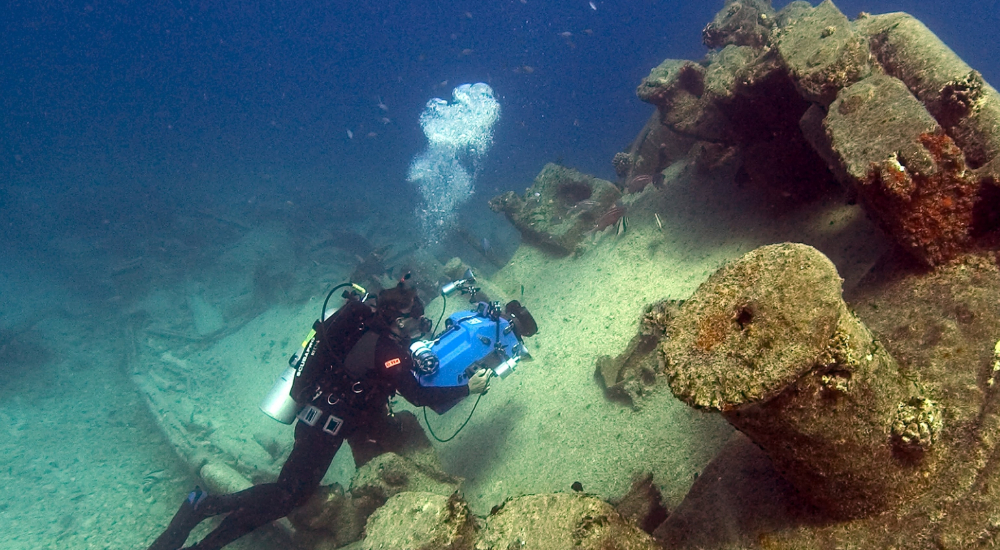Underwater cultural heritage sites are fascinating for both researchers and the general public. Some of these spots are not easily accessible, but thanks to the advancements in technology it is now possible to explore these magnificent sites without getting wet. We’ve compiled some of the most interesting virtual underwater museums so you can discover historical wrecks from behind the screen.
Virtual Open-Air Museum of Wrecks in the Gulf of Gdańsk
If you live outside of Europe, there’s no need to travel to the old continent to dive into the depths of the Baltic Sea. Archaeologists at the National Maritime Museum in Gdańsk have brought the wrecks at the bottom of the Gulf to the virtual world.
The Virtual Museum of Wrecks in the Gulf of Gdańsk is a branch of the National Maritime Museum (NMM) in Gdańsk and allows visitors to take a virtual tour of the seabed to see wrecks of historical importance such as the Solen – a Swedish battleship that sank in 1627 during the Battle of Oliwa – and De Jonge Seerp – a Frisian „kuff” that sank in 1791.
This virtual museum displays 3D photogrammetric models of wrecks accompanied by their descriptions. The models reproduce the actual appearance of the wrecks lying on the bottom of the Gulf of Gdańsk, which proved to be a difficult task for underwater archaeologists given the harsh conditions prevailing in the Baltic Sea.
Virtual Underwater Museum of Malta
Opened in 2020, Malta’s Virtual Underwater Museum offers people a way to access the underwater wreck sites of the country from the comfort of their homes. The platform features ten dive sites, including the 7th-century-BC Phoenician shipwreck, the popular HMS Maori Tribal-class destroyer, the B-24 Liberator American heavy bomber, and the HMS Stubborn S-class submarine.
Many of the wrecks lie very deep and are otherwise accessible only to technical divers. Fortunately, Virtual Reality video, 3D models, and photography can and have been used to provide users with an immersive underwater experience. You can also learn about the history of the ships or aircraft and glance through historical images and sketches that show how the wrecks used to look like.
The Thistlegorm Project
This ongoing underwater archaeological survey project aims to raise awareness of the cultural heritage that lies beneath the surface of the Red Sea. It is a collaboration between the University of Nottingham, Ain Shams University, and Alexandria University and is part of the Presence in the Past project.
The SS Thistlegorm was a British armed Merchant Navy ship that sank in October 1941 after receiving hits from two German Heinkel He 111 bombers. It was discovered in the early 1950s by renowned explorer Jacques Cousteau, who found the ship using information from local fishermen.
The wreck has since become highly popular among scuba divers, but this proves to be a problem as the number of boats that moor to the wreck are damaging the site. This project will enable any future changes to the structure to be monitored. The platform offers interactive 3D models of the wreck (including its inside rooms) and 360° videos for an immersive experience.
Bermuda 100
The Bermuda 100 Challenge is a massive project whose aim is to create a comprehensive digital atlas of the numerous wrecks surrounding the country of Bermuda. The nation is often considered the shipwreck capital of the world, and with such a rich history lying beneath the surface of the water, an initiative of this kind can also help educate the public on the importance of protecting these precious pieces of the past.
The website provides an archive of multimedia and other data documenting more than 30 shipwrecks and an aircraft wreck. On the page of each wreck, you can find information on the history of it and its current state as well as photos, interactive 3D models, and videos. The local divers, scientists, and archaeologists working on the project are hoping to document at least 100 ships and artifacts, so keep an eye on the project as more wrecks will be added in the future.
Scapa Flow Historic Wreck Site
Scapa Flow is a large expanse of water surrounded by the Orkney Isles, on the northeast coast of Scotland. This world-renowned location is home to a diversity of wrecks, many of which served in WWI and WWII. It is reported that about 3,000 divers visit Scapa Flow each year to explore these magnificent wrecks. But it’s also possible to see them from behind the screen.
The Scapa Flow Historic Wreck Site is a project that brings you information on the dozens of historical wrecks that rest on the bottom of the sea at Orkney. You can learn about the history of the wrecks, information on the diving conditions, and what you can find at the sites as well as interactive 3D models, photos, and videos.
Virtual Dive Trails of Protected Wreck Sites
An executive non-departmental public body of the British Government sponsored by the Department for Digital, Culture, Media and Sport, Historic England offers visitors the opportunity to take a virtual tour to discover numerous shipwrecks that have sunk in English waters. The virtual dive trails use advanced technologies such as multi-image photogrammetric recording and virtual reality so you can get clear 3D images of the sites.
Some of the wrecks you can tour virtually include the well-preserved HMT Arfon – an armed trawler from WWI, the HMS Colossus – a warship that sank in 1798, the famous London wreck – a former Navy ship that was accidentally blown up in 1665, and the Invincible – a revolutionary French warship that was wrecked in 1758.
Are there any wrecks on your bucket list you have yet to get up-close to?
